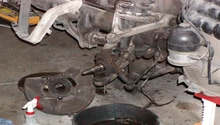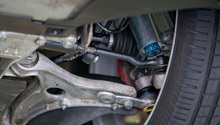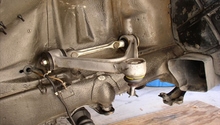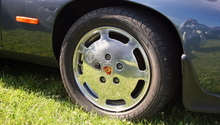Porsche 997: Do I Have a Bad Wheel Alignment?
A bad wheel alignment can cause the steering wheel to not be centered, the car to pull to one side while driving down the road, and poor tire wear among other issues. If you are concerned about a possible alignment issue on your 997, then read on to diagnose it.
This article applies to the Porsche 997 (2005-2012).
A bad alignment can cause all sorts of problems, both inconvenient and dangerous. Your car could be pulling to one side, making odd noises, or perhaps even exhibiting poor ride quality. Whatever the symptom, the result can be broken parts, uneven wear on tires, or other various damage. Diagnosing the cause of a poor alignment is fairly easy if you know what to look for. Keep reading for the steps on how to do so, and you'll be back on the road to a smooth ride in no time.
Step 1 – Check the tires
Start by inspecting your tires, looking for any uneven or excessive wear, and check your tire pressure to make sure your tires aren't over or underinflated. Even a one-time, unexpected run-in with a pothole is enough to throw your 997's sensitive suspension out of whack and lead to uneven tire wear. The chart below can help you diagnose various wear patterns on your tires.
(Related Article: How to Check Tire Pressure on a 997 - Rennlist.com)

Step 2 – Check the shocks
If your car is bouncing excessively when you drive over a bump, your tires are "cupped" or "scalloped", or if it nose dives or squats under braking or acceleration, your shocks or struts might be bad. You can also check your shocks by pushing down on each corner of the car. If it bounces multiple times instead of just coming back up, it's time to shop for some new shocks or struts.

Step 3 – Check the control arms
Symptoms of a bad control arm include shaking, vibrations, loose steering, and rattles or clunking noises while driving. If your control arms are bad, vibrations in the car's steering will get worse at higher speeds and should be very noticeable on the freeway. The steering wheel may shake when you apply the brakes, and steering will feel sloppy or loose.
Jack the car up until each wheel is fully suspended in the air and try to move the wheel by placing a hand on either side of it. If the wheel moves freely, you likely have bad control arms. The most common issue with the control arms are the rubber bushings, which over time, can become damaged or wear out. These can be visually inspected from beneath the car.
(Related Article: How to Jack Up a 997 - Rennlist.com)

Step 4 – Check the bushings
Symptoms of bad bushings include clunking and rattling noises and sloppy or loose steering. The common bushings to wear out on the 997 involve the subframe mounting points, the control arms, and the sway bar mounts. Visually inspect the bushings by lifting the car up and placing it on jack stands, then locate the bushings at each end of the sway bar. If the bushings are damaged or missing altogether, they can be easily replaced by simply removing the sway bar and installing new ones.

Step 5 – Check the tie rods
Symptoms of a bad tie rod include a shaky steering wheel, vibrations that increase with speed or as you turn, and uneven tire wear caused by excessive toe. Complete failure of tie rods can cause a total loss of steering, which is obviously very dangerous. The best way to inspect tie rods is to use a wheel alignment rack, with the wheel properly supported and tie rods at their normal angles. Push in and out at the front of the tires to check for excessive slack, which indicates that the tie rods are bad.
(Related Article: How to Replace Tie Rod Ends on a 997 - Rennlist.com)

Related Discussions
- Alignment and Camber Settings for 997 - Rennlist.com
- Bad Alignment Job - Rennlist.com
- 2005 Wiggling Bushing Issue - Rennlist.com






